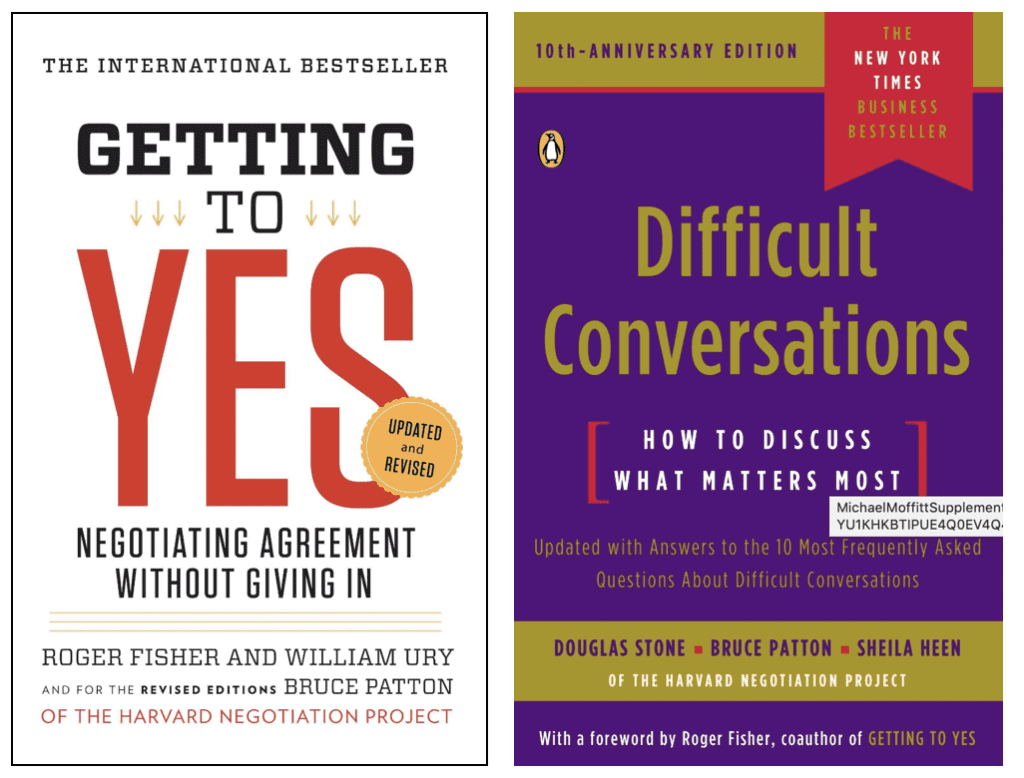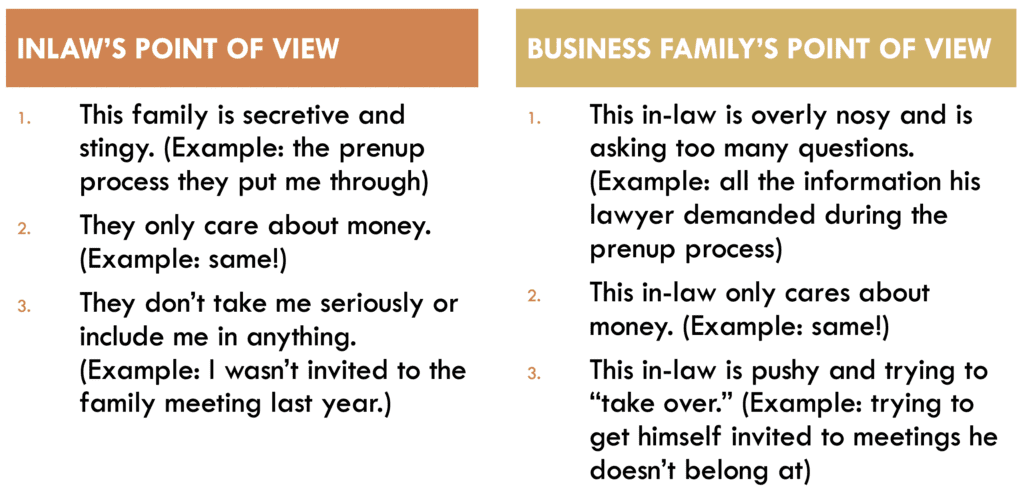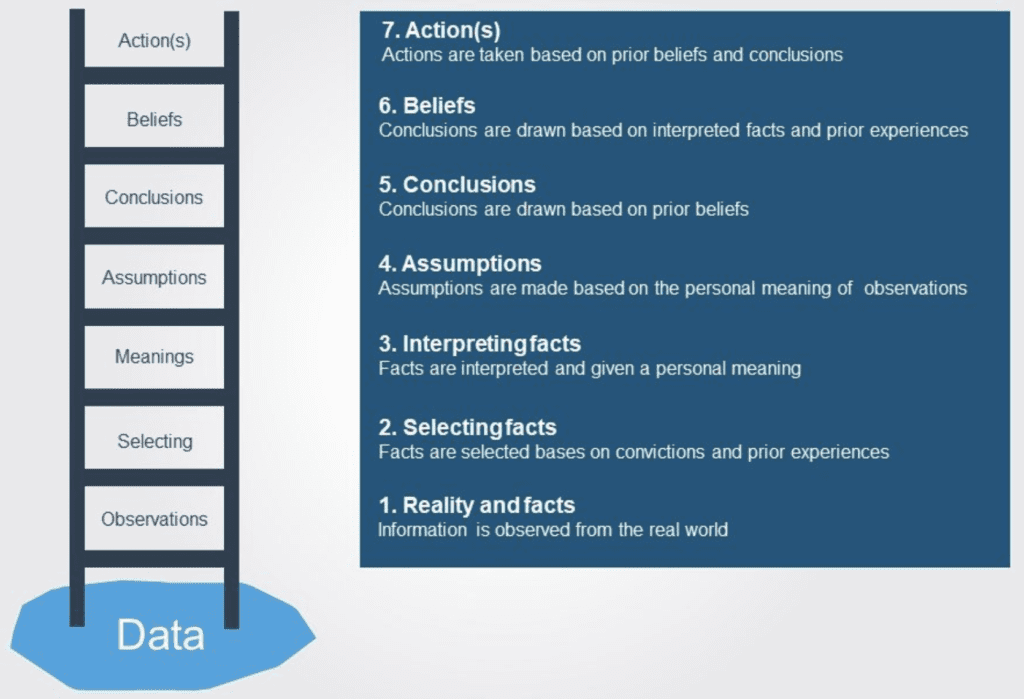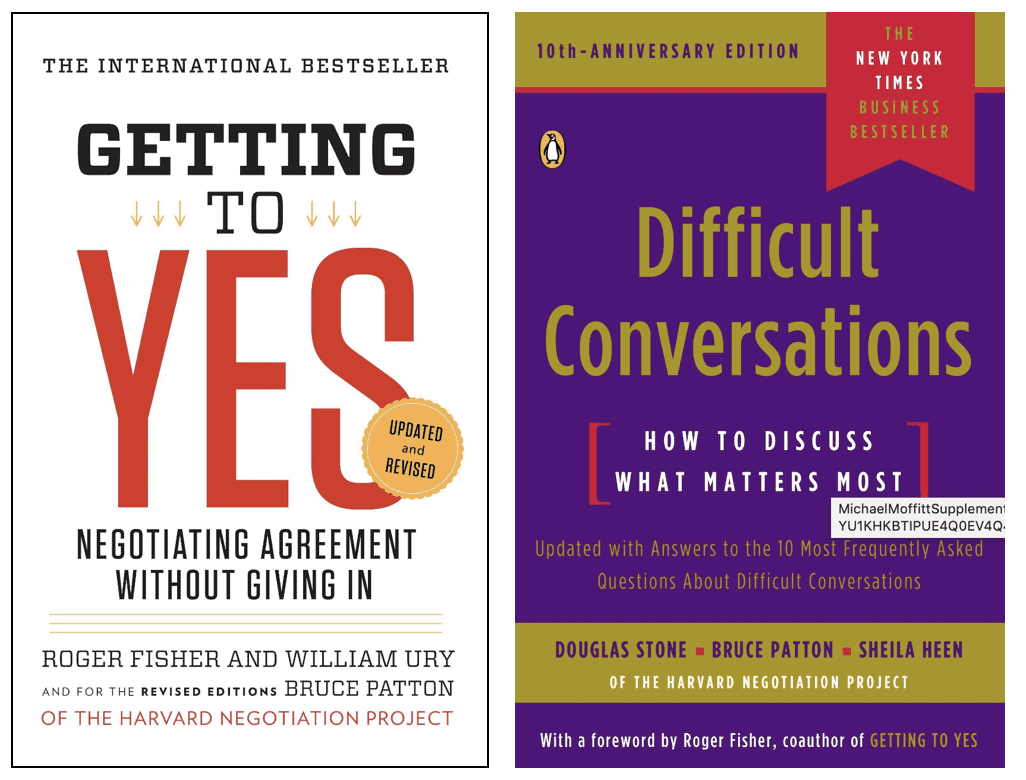Lots of families in business worry about in-laws. What if a spouse has married into the family “just for the money?” What if he or she tries to “take over” or is overly opinionated? What if the in-law creates conflict? What if he or she is a “gold-digger” or spendthrift?
Although less often discussed, in-laws have worries about business families as well. What is this family business or enterprise, and why does everyone seem so worried about it? Who are all these lawyers, advisors, and other professionals circling around my spouse and his or her family? Why does it seem like everyone is so secretive? Or uptight? Or obsessive about money?
Where You Stand Depends on Where You Sit
The conflict and negotiation literature has long focused on such examples of “partisan perceptions”–situations in which two parties have very different views on the same subject, and in which those views tend to harden over time rather than lead to mutual understanding or learning and change. Roger Fisher, the author of Getting to Yes and one of the great thinkers on negotiation, long repeated the old proverb: where you stand depends on where you sit. Put differently, your views often depend on your vantage point. As an example, if you’re a business family member, you may have one set of views about “the in-law issue,” whereas if you’re an in-law you will likely have a very different perspective.

The two best books out there on partisan perceptions and how to deal with them
Getting to Yes and its successor, Difficult Conversations, are the two best books I know of on the problem of partisan perceptions and how to deal with it. I had the privilege of working at the Harvard Negotiation Project with the authors of these books for several years, and I have taught from them in the decades since. If you haven’t already, I encourage you to read them both.
A Partisan Perceptions Tool
Those kudos behind us, in this post I want to use one simple tool from this literature to illustrate how thinking through partisan perceptions can be helpful in the family enterprise context.

Figure 1: A Partisan Perceptions Chart
A partisan perceptions analysis maps out the competing points of view of two parties who see the same issues very differently. The tool is as simple as dividing a piece of paper into two columns, one for each party. The idea is to write down the main issues in dispute in the partisan way that one side views or “frames” those issues, and then to do the same for each issue from the other side’s perspective. In doing this, you don’t try to moderate or soften the views: you are trying to capture just how differently the two parties see the same thing. As I sometimes say to parties in conflict, “you seem to be living on different planets.” The point of this exercise is to describe in rich detail what those different planets look like from the point of view of their respective inhabitants.
Figure 1 gives a simple example, again using in-laws in a family enterprise. Imagine a situation in which an entering in-law is experiencing conflict with the family, the patriarch, or others in the family system. Maybe things got off on the wrong foot: the incoming spouse was treated clumsily during the prenup process, or has had a run-in or two with members of the family. Maybe the family distrusts the new in-law for some reason, or is suspicious of her motives. Whatever it is, the goal is to map out the very different perceptions that each side has.
The Ladder of Inference Tool
Looking at Figure 1 identifies not only very different points of view and some hostility, but also that two events in particular–the prenup and the most recent family meeting–have contributed to these differences. Each side sees these specific events very differently. In working through partisan perceptions, it can be helpful to dig in to such examples or events and try to unpack how it is that they led to such different “planets.”

Figure 2: The Ladder of Inference
Another tool, originally conceived by Chris Argyris of the Harvard Business School and Peter Senge of MIT Sloan, can be useful here. This tool is called the Ladder of Inference.
The Ladder of Inference helps you to unpack how it is that two people experienced the same event–or looked at the same information–but arrived at two completely different conclusions about it. It is a simple model. “Low” on the Ladder are the facts and data points that the person actually saw or experienced. As you climb “up” the Ladder, you are abstracting away from those data points. First, not all data are actually absorbed: we select certain facts from all of those available, often in biased or imperfect ways based on our own convictions and prior experiences. Second, we interpret those selected facts according to our own interpretive rules. If someone is crossing their arms during a meeting, are they tired, angry, withdrawn, or closed-minded? That interpretation depends on your own interpretive rule in your head. Third, we make assumptions about what those interpretations mean. We abstract. We’ve noticed the crossed arms, we’ve interpreted that as closed-mindedness, and now we assume that the person is “checked out” and “not interested.” Then we draw conclusions. Our view hardens. We label. “They’re not open to learning.” “They’re difficult.” And so on. If we hold this view over time–probably looking for and adding more confirmatory (but biased) data to support it–it congeals into a belief. And we take action on that belief or conclusion. Often the action is itself self-sealing–created by this inferential process that led to the conclusion behind the action, but in itself likely to create confirmatory information, not disconfirm our inferences. For example, we may stop trying to reach the person with the crossed arms, uninviting them from a future meeting “because” they’re “not interested.” They disengage from the project or team. Our view is confirmed–“see, they weren’t interested.” But in fact, we helped create that outcome … all because they had a stomach ache that morning and crossed their arms because it felt better to put some pressure on their abdomen.
Partisan perceptions are fueled by this inferential process. There’s more going on as well–emotion, identity issues, etc. Again, read the Difficult Conversations book if this interests you. But at base, the Ladder of Inference can be a very useful construct to help understand how such different views can get created.
In the in-laws story above, one can imagine that not getting invited to a family meeting, for example, could be interpreted by the in-law as exclusive, harsh, mean, rejecting, or insulting. “Sure, the family says they only invite you once you’re officially engaged, but everybody knows we’re going to get married eventually. They don’t want me there because they don’t like me.” The inferential process is so quick and so devious, because we’re often not aware that we’ve done anything. The conclusion–about them and what they think–seems “true” to us. Obvious. Self-evident. As both people in a disagreement race “up the Ladder,” they end up with hardened and very different beliefs about themselves, each other, and the disagreement itself.
Any professional working with a multigenerational family or family enterprise had better understand partisan perceptions, how they are formed, and how to help counter them.
All of this requires patient work to unpack and undo. I’ll leave this post there–but just end by saying that any professional working with a multigenerational family or family enterprise had better understand partisan perceptions, how they are formed, and how to help counter them. It would be wonderful if everyone in a family enterprise system had such good perspective-taking ability that partisan perceptions never formed. That is so unlikely, however, as to be laughable. Instead, both preventing and un-doing partisan perceptions are daily tasks.

